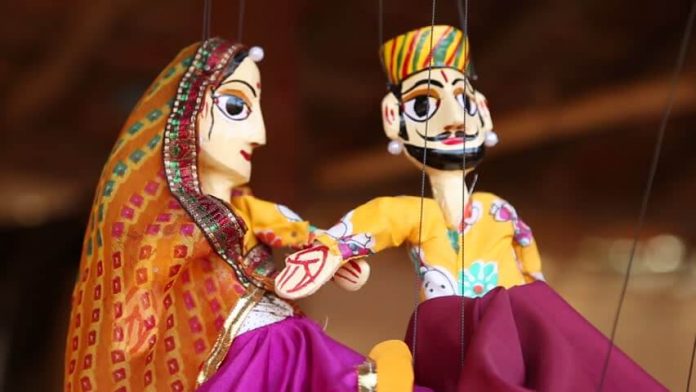This article is written by Sonia Balhara, from Sushant University, Gurgaon. This article deals with the question which comes to every person’s mind that under the Copyright Act, are kathputlis protected and do they have some rights under this Act.
Table of Contents
Introduction
The art of creating kathputlis was given by the Bhaat community of Rajasthan as a kind of entertainment ages ago. The word kathputli is a mixture of two words ‘kaath’ meaning wood and ‘putli’ meaning a doll. The inner body structure of the puppet is formed from wood and so it’s given decorations with types of metal jewellery, clothes, and a few metal works. This piece maps the belonging rights framework for both puppets of the normal variety and kathputlis particularly. The Bhaats found support and encouragement from the royal and aristocratic families of Rajasthan, performing epics declaring the life and deeds of the great kings and their ancestors until the Mughal incursion saw a change in taste and also the demand for his or her craft diminished. Though, the concurrent descendants of the bhats, called Nat Bhat (those who perform plays), still share the wandering life of their ancestors, travelling from a village in troupes performing acts that reveal local history, story, and legend. First, let’s understand where the normal kathputlis are placed within the prospect of Intellectual Property Rights.
Status of traditional handicrafts
Traditional handicrafts are images of the cultural heritage of any country. In India, the importance of traditional handicrafts becomes more appealing because of its rich heritage and diverse culture. In India, the Constitution, through Article 29, guarantees the fundamental right to the individual to shield his culture and heritage. Traditional handicrafts play an important role in serving this purpose and thus, they need to be protected.
The main idea behind the copyright law is to functionalize a balance between the interest of the creator of the content and the general public interest in having the widest accessibility to the content. Copyright protection is not only available to literary works but also artistic works. As in keeping with Section 2(c) of the Copyrights Act, 1957, artistic works include:
- A painting, a scripture, a drawing (including a diagram map, chart or plan) on engraving or a photograph, whether or not such work possesses an artistic quality,
- A work of architecture,
- Any other work of artistic craftsmanship.
Related Acts and statues
In respect of handicrafts, it is vital to possess the excellence between traditional and technical handicrafts. The protection can only be provided to traditional handicrafts as they are a significant source of the custom of any society and it is the responsibility of the legislature to provide protection to the rich custom of India. The status of traditional handicrafts is deduced from the following statutes and Acts:
The Copyright Act, 1958
The Copyright Act provides that copyright subsists in an exceedingly resourceful literary, exciting, artistic work, cinemas, and sound cassettes. However, no copyright subsists in a very cinematographic film if a substantial part of the film is an infringement of the copyrights within the other work or in an exceedingly recording if in making the record of a literary, dramatic, or artistic work, copyright in such work is violated. Software is treated as a literary work and is protected intrinsically. Following rights are given under copyright acts:
- Reproduce or add any form, like print, sound, video, etc;
- Utilization of the work for a public performance, kind of a play or a vocal work;
- Make copies/cassettes of the work, like via compact discs, etc;
- Broadcast it in various forms; or
- Translate the clone of other languages.
Berne’s rule for the Protection of Literary and Artistic Works, 1886
India is a member of the above convention. To accommodate the convention, India laid out the International Copyright Order in 1958. Keeping with this order, any work first published in any country which can be a member of any of the above conventions is granted the identical treatment as if it had been first published in India.
Protection under Geographical Indications of products (Registration and Protection) Act, 1999
According to this Act, ‘handicrafts are those items which are made by hand, often with the help of effortless tools, and are usually artistic, or traditional. They may include objects of usefulness and decoration’.
According to the TRIPS agreement, popular handiworks were sought to be protected by way of Geographical Implications under national laws. The Geographical Indications of products (Registration and Protection) Act, 1999 states the procedure for registration of Geographical Indications and illuminates the view of an authorized user and registered owner, both of them who can originate action for violation. During this process of registration, the government plays an important role because it can register the quality handicrafts by itself by becoming the clear holder of the conventional handicrafts as most of the craftsmen who make these handicrafts are ignorant about the price of their creation. By becoming clear holders, it not only protects the traditional handicrafts but also corrects artisans in realizing the price of their creation.
The Design Act, 2000
The ‘copyright’ is defined in Section 2(c) which gives the proper right to use a design to any article in any class within which the look is registered.
The design Act puts most of the force behind the protection of the design activity for the external outlook of traditional handicrafts but it only protects the design of the article, not the thing itself. As an example, rice crafting in Rajasthan where miniatures are drawn on one grain of rice, under the purview of designs act, 2000, only the miniature design is protected, not the complete model of rice. Section 2(d) of the Designs Act, 2000 and Section 2(c) of the copyright act,1957 should be read together and thoroughly to differentiate the design of the article and the object itself. It’s significant to note here that designs act awards rights only to non-functional features of a design, so if a particular design is predominantly working then it cannot be qualified for a design right.
Kathputlis as traditional knowledge
Kathputli, a unique art of Indian puppetry would comprise, what we now know as traditional knowledge. Thanks to the assorted shortcomings of protecting traditional knowledge. Intrinsically (for instance, lack of documentation, Dolores and methods being vocal, unidentifiable inventors, etc). Kathputlis are protected by India under its Geographical Indications regime within the class of ‘handicrafts’. The protection is on the market up to 2026, after which its sustained protection would be controlled to the amount of an enrollment fee. The certificate states the event Commissioner (handicrafts), Ministry of Textiles, Geographical Indications, national capital to be the registered owner.
The truth that emerges doesn’t present a hopeful picture of the socio-economic status of the community, performing kathputlis is taken as a symbol. The registration details of the Geographical Indications certificate for Kathputlis reveal six authorized users, mostly based within the Makrana and Didwana district of Rajasthan. Bhaat, the community mentioned earlier, as an example, comes under the Dalit domain contemporary supporters of art and also the revolt within the community youth who needs a more economically viable profession with a daily income. An art that has lost its patrons may be a dying one and it’s unlikely that the stakeholders involved would bear in mind their belonging rights.
After having briefly checked out the status of kathputlis under the Geographical Indications regime, it’s useful to look at the copyright protection of puppets normally, which might operate concomitantly with the Geographical Indications protection of kathputlis. The two enactments that will be of some importance here are the Copyright Act, 1957, and therefore the Designs Act, 2000.
Are kathputlis or puppets protected under the Copyright Act
Are kathputlis protected as art under the copyright law? What rights do I have if I make a kathputli? What if the kathputli or puppet is mass-produced, more than 50 times?
Firstly, copyright is there in kathputlis if they meet the standard of being a part of a ‘fragment of creativity’. But, if the puppets are common and of ‘run-of-the-mill variety’, they will not be fit to be original.
Copyright Act, however, doesn’t protect purely utilitarian aspects of a piece. So, the important question is that would make a kathputli or puppet which is not similar to a toy, usually hand-made, expected to be played with hands, strings, rods, and other such assistance, not classified as a useful object; hence not manageable to copyright safeguard?
We don’t have any Indian case law that will throw a light on the copyrightability of toys. Nevertheless, we do have plenty of foreign cases that have held in favour of their copyrightability. In the case of Gay Toys Inc. v. Buddy L. Corp, the court held that the toy plane wasn’t a ‘useful object’ possessing useful and functional features. It was held that toys don’t have any intrinsic function apart from the portrayal of the important item and are protectable by copyright. The case of LEGO A/S v. Best-Lock Construction Toys Inc., D. Conn. also repeats the same opinion. Minifigures of LEGO usually have movable torsos and hands. This was imagined to be a functional element by the best lock. Refusing this claim, the US district court said that LEGO torso shapes were a resourceful element and strengthened them more.
Therefore, it can be said that kathputli or puppets, being toys, cannot be considered utilitarian and their creative components can be considered as artwork if copyright is found to be original.
Coming to the second question- here, Section 15(2) of the Copyright Act, 1957 creates a definite linkage with the Designs Act, 2000 to give a transparent answer. It states that ‘copyright in any design which is capable of being registered under the Designs Act, 2000 but which has not been registered shall cease as soon as any article to which the look has been applied or reproduced over fifty times by a process by the owner of the copyright or, along with his license, by the other person. Transposing the above understanding to the case of puppets, if the outer appearance of the puppets is replicated quite 50 times, the copyright which could have subsisted within the puppets’ artistic work ceases. This may leave them unprotected under both copyright law and design law.
Conclusion
Simply put, it seems that whether it’s a buying deal of the quality kathputli (as protected under Geographical Indications) or a simple puppet which can be a copyright subject material as resourceful work- the rights that the buyer has with them are quite limited, some even doubtful. Whether the holder of the rights of those puppets would be desirous to vindicate them, one even has the means to achieve that, could also be a distinct matter altogether. As an example, coming to the Bhaat community where the making of kathputlis is now confined, it’s safe to assume that given their socio-economic status, literacy, and lack of zeal to see their rights, it’s incredible that any such violation as above would ever come to the light. Certainly, this inclination is just to tolerate many types of violation.
Also, one must not forget that an adaptation is an enabling right and not a spelling one. So any rigorous reading of the rights may not get favoured even legally. The endeavour of this post was just to spotlight how the world of Intellectual Property (IP) interacts with puppets. On a positive note, it hoped that the Entrepreneurship Development Institute of India (EDI) which has been founded to develop entrepreneurial capabilities in weavers, artisans, and merchants to support hand-made art, would include within its fold, the nearly lost art of making kathputlis. This could not only provide some help to the Bhaat community but also provide the desired stimulus and motivation to other artisans/creators of puppets to allow them to work out their rights.
References
- https://spicyip.com/2020/01/bol-ree-kathputli-tell-me-o-kathputli-what-ip-rights-do-i-have-in-you.html
- https://www.mondaq.com/india/copyright/447532/india-copyright-guide-frequently-asked-questions-indian-copyright-act-1957
- https://papers.ssrn.com/sol3/papers.cfm?abstract_id=2625845=
LawSikho has created a telegram group for exchanging legal knowledge, referrals and various opportunities. You can click on this link and join:
 Serato DJ Crack 2025Serato DJ PRO Crack
Serato DJ Crack 2025Serato DJ PRO Crack











 Allow notifications
Allow notifications



